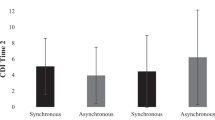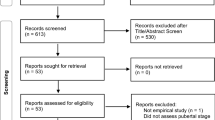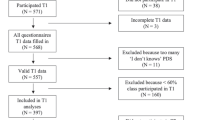Abstract
Puberty is accompanied by numerous psychological and interpersonal challenges, including a dramatic rise in the prevalence of depression among girls. Pubertal timing has been identified as a potent predictor of depressive symptoms among females, but less is known about other features of puberty. The present study sought to address this gap in the literature by examining the effect of pubertal synchrony, the degree to which morphological indicators of puberty develop concurrently, on depressive symptoms in adolescence and emerging adulthood in a longitudinal sample. Among 355 female participants, asynchronous development at age 13 was associated with increased depressive symptoms at age 20, but not age 15. Additional analyses indicated that pubertal timing moderated the association between synchrony and depressive symptoms at age 20, such that girls who exhibited asynchronous development had the highest levels of depressive symptoms when they matured later than peers. Results provide initial empirical support for the role of pubertal synchrony in the development of depression among females and are discussed with regard to the biopsychosocial processes that may connect features of puberty with the long-term development of psychopathology.


Similar content being viewed by others
References
Achenbach, T. M. (1991). Manual for the youth self-report and 1991 profile. Burlington, VT: University of Vermont Department of Psychiatry.
Angold, A., Costello, E. J., Erkanli, A., & Worthman, C. M. (1999). Pubertal changes in hormone levels and depression in girls. Psychological Medicine, 29, 1043–1053.
Angold, A., Costello, E. J., & Worthman, C. M. (1998). Puberty and depression: The roles of age, pubertal status and pubertal timing. Psychological Medicine, 28(1), 51–61.
Arnett, J. J. (2014). Emerging adulthood: The winding road from the late teens through the twenties. Oxford, UK: Oxford University Press.
Beck, A. T. (1987). Cognitive models of depression. Journal of Cognitive Psychotherapy: An International Quarterly, 1, 5–37.
Beck, A. T., Steer, R. A., & Brown, G. K. (1996). Beck depression inventory-II manual. San Antonio, TX: The Psychological Corporation.
Bedford, A., & Foulds, G. (1978). Delusions-symptoms-states inventory of anxiety and depression. Windsor, UK: National Foundation for Educational Research.
Benoit, A., Lacourse, E., & Claes, M. (2013). Pubertal timing and depressive symptoms in late adolescence: The moderating role of individual, peer, and parental factors. Development and Psychopathology, 25(2), 455–471.
Biro, F. M., Lucky, A. W., Simbartl, L. A., Barton, B. A., Daniels, S. R., & Morrison, J. A. (2003). Pubertal maturation in girls and the relationship to anthropometric changes: Pathways through puberty. Journal of Pediatrics, 142(6), 643–646.
Brooks-Gunn, J. (1984). The psychological significance of different pubertal events to young girls. Journal of Early Adolescence, 4(4), 315–327.
Brooks-Gunn, J., Newman, D. L., Holderness, & Warren, M. P. (1994). The experience of breast development and girls’ stories about the purchase of a bra. Journal of Youth and Adolescence, 23(5), 539–565.
Brooks-Gunn, J., & Ruble, D. N. (1982). The development of menstrual-related beliefs and behaviors during early adolescence. Child Development, 53(6), 1567–1577.
Brooks-Gunn, J., & Warren, M. P. (1985). Measuring physical status and timing in early adolescence: A developmental perspective. Journal of Youth and Adolescence, 14(3), 163–189.
Brooks-Gunn, J., Warren, M. P., Rosso, J., & Garguilo, J. (1987). Validity of self-report measures of girls’ pubertal status. Child Development, 58(3), 829–841.
Caspi, A., Lynam, D., Moffitt, T. E., & Silva, P. A. (1993). Unraveling girls’ delinquency: Biological, dispositional, and contextual contributions to adolescent misbehavior. Developmental Psychology, 29(1), 19–30.
Caspi, A., & Moffitt, T. E. (1991). Individual differences are accentuated during periods of social change: The sample case of girls at puberty. Journal of Personality and Social Psychology, 61(1), 157–168.
Conley, C. S., & Rudolph, K. D. (2009). The emerging sex difference in adolescent depression: Interacting contributions of puberty and peer stress. Development and Psychopathology, 21, 593–620.
Copeland, W., Shanahan, L., Miller, S., Costello, E. J., Angold, A., & Maughan, B. (2010). Outcomes of early pubertal timing in young women: A prospective population-based study. American Journal of Psychiatry, 167(10), 1218–1225.
Dahl, R. E., & Gunnar, M. R. (2009). Heightened stress responsiveness and emotional reactivity during pubertal maturation: Implications for psychopathology. Development and Psychopathology, 21, 1–6.
Dorn, L. D., Dahl, R. E., Woodward, H. R., & Biro, F. (2006). Defining the boundaries of early adolescence: A user’s guide to assessing pubertal status and pubertal timing in research with adolescents. Applied Developmental Science, 10(1), 30–56.
Dorn, L. D., Susman, E. J., & Ponirakis, A. (2003). Pubertal timing and adolescent adjustment and behavior: Conclusions vary by rater. Journal of Youth and Adolescence, 32(3), 157–167.
Duke, P. M., Litt, I. F., & Gross, R. T. (1980). Adolescents’ self-assessment of sexual maturation. Pediatrics, 66(6), 918–920.
Eichorn, D. H. (1975). Asynchronizations in adolescent development. In S. E. Dragastin & G. H. Elder (Eds.), Adolescence in the life cycle: Psychological change and social context. Washington, DC: Hemisphere.
Ellis, B. J., & Essex, M. J. (2007). Family environments, adrenarche, and sexual maturation: A longitudinal test of a life history model. Child Development, 78(6), 1799–1817.
First, M. B., Spitzer, R. L., Gibbon, M., & Williams, J. B. W. (1995). Structured clinical interview for DSM-IV axis I disorders. Washington, DC: American Psychiatric Press.
Ge, X., & Natsuaki, M. N. (2009). In search of explanations for early pubertal timing effects on developmental psychology. Current Directions in Psychological Science, 18(6), 327–331.
Graber, J. A. (2013). Pubertal timing and the development of psychopathology in adolescence and beyond. Hormones and Behavior, 64, 262–269.
Graber, J. A., Lewinsohn, P. M., Seeley, J. R., & Brooks-Gunn, J. (1997). Is psychopathology associated with the timing of pubertal development? Journal of the Academy of Child and Adolescent Psychiatry, 36(12), 1768–1776.
Graber, J. A., Seeley, J. R., Brooks-Gunn, J., & Lewinsohn, P. M. (2004). Is pubertal timing associated with psychopathology in young adulthood? Journal of the American Academy of Child and Adolescent Psychiatry, 43(6), 718–726.
Hammen, C. (2003). Interpersonal stress and depression in women. Journal of Affective Disorders, 74(1), 49–57.
Henry, J. D., Crawford, J. R., Bedford, A., Crombie, C., & Taylor, E. P. (2002). The personal disturbance scale (sAD): Normative data and latent structure in a large non-clinical sample. Personality and Individual Differences, 33(8), 1343–1360.
Kaplowitz, P. B., Slora, E. J., Wasserman, R. C., Pedlow, S. E., & Herman-Giddens, M. E. (2001). Earlier onset of puberty in girls: Relation to increased body mass index and race. Pediatrics, 108(2), 347–353.
Keeping, J. D., Najman, J. M., Morrison, J., Western, J. S., Andersen, M. J., & Williams, G. M. (1989). A prospective longitudinal study of social, psychological and obstetric factors in pregnancy: Response rates and demographic characteristics of the 8556 respondents. British Journal of Obstetrics and Gynaecology, 96(3), 289–297.
Kessler, R. C. (2003). Epidemiology of women and depression. Journal of Affective Disorders, 74(1), 5–13.
Kuehner, C. (2003). Gender differences in unipolar depression: An update of epidemiological findings and possible explanations. Acta Psychiatrica Scandinavica, 108(3), 163–174.
Lewinsohn, P. M., Rohde, P., Klein, D. N., & Seeley, J. R. (1999). Natural course of adolescent major depressive disorder: I. Continuity into young adulthood. Journal of the American Academy of Child and Adolescent Psychiatry, 38(1), 58–63.
Marceau, K., Ram, N., Houts, R. M., Grimm, K. J., & Susman, E. J. (2011). Individual differences in boys’ and girls’ timing and tempo of puberty: Modeling development with nonlinear growth models. Developmental Psychology, 47(5), 1389–1409.
Markiewicz, D., Lawford, H., Boyle, A. B., & Haggart, N. (2006). Developmental differences in adolescents’ and young adults’ use of mothers, fathers, best friends, and romantic partners to fulfill attachment needs. Journal of Youth and Adolescence, 35(1), 127–140.
Marti-Henneberg, C., & Vizmanos, B. (1997). The duration of puberty in girls is related to the timing of its onset. Journal of Pediatrics, 131(4), 618–621.
Mendle, J. (2014). Beyond pubertal timing: New directions for studying individual differences in development. Current Directions in Psychological Science, 23(3), 215–219.
Mendle, J., Harden, K. P., Brooks-Gunn, J., & Graber, J. A. (2010). Development’s tortoise and hare: Pubertal timing, pubertal tempo, and depressive symptoms in boys and girls. Developmental Psychology, 46(5), 1341–1353.
Mendle, J., Harden, K. P., Brooks-Gunn, J., & Graber, J. A. (2012). Peer relationships and depressive symptomatology in boys at puberty. Developmental Psychology, 48(2), 429–435.
Mendle, J., Turkheimer, E., & Emery, R. E. (2007). Detrimental psychological outcomes associated with early pubertal timing in adolescent girls. Developmental Review, 27, 151–171.
Morris, N. M., & Udry, J. R. (1980). Validation of a self-administered instrument to assess stage of adolescent development. Journal of Youth and Adolescence, 9, 271–280.
Natsuaki, M. N., Biehl, M. C., & Ge, X. (2009). Trajectories of depressed mood from early adolescence to young adulthood: The effects of pubertal timing and adolescent dating. Journal of Research on Adolescence, 19(1), 47–74.
Novotny, R., Daida, Y., Morimoto, Y., Shepherd, J., & Maskarinec, G. (2011). Puberty, body fat, and breast density in girls of several ethnic groups. American Journal of Human Biology, 23(3), 359–365.
O’Sullivan, L. F., Meyer-Balhburg, H. F. L., & Watkins, B. X. (2000). Social cognitions associated with pubertal development in a sample of urban, low-income, African-American and Latina girls and mothers. Journal of Adolescent Health, 27(4), 227–235.
Obeidallah, D. A., Brennan, R. T., Brooks-Gunn, J., Kindlon, D., & Earls, F. (2000). Socioeconomic status, race, and girls’ pubertal maturation: Results from the project on human development in Chicago neighborhoods. Journal of Research on Adolescence, 10(4), 443–464.
Osman, A., Barrios, F. X., Gutierrez, P. M., Williams, J. E., & Bailey, J. (2008). Psychometric properties of the beck depression inventory-II in nonclinical adolescent samples. Journal of Clinical Psychology, 64(1), 83–102.
Petersen, A. C., & Taylor, B. (1980). The biological approach to adolescence: Biological change and psychological adaptation. In J. Adelson (Ed.), Handbook of adolescent psychology (pp. 117–155). New York: Wiley.
Rao, U., Hammen, C., & Daley, S. E. (1999). Continuity of depression during the transition to adulthood: A 5-year longitudinal study of young women. Journal of the American Academy of Child and Adolescent Psychiatry, 38(7), 908–915.
Rudolph, K. D. (2008). Developmental influences on interpersonal stress generation in depressed youth. Journal of Abnormal Psychology, 117(3), 673–679.
Rudolph, K. D. (2014). Puberty as a developmental context of risk for psychopathology. In M. Lewis & K. D. Rudolph (Eds.), Handbook of developmental psychopathology (3rd ed., pp. 331–354). New York: Springer.
Rudolph, K. D., & Troop-Gordon, W. (2010). Personal-accentuation and contextual- amplification models of pubertal timing: Predicting youth depression. Development and Psychopathology, 22, 433–451.
Schulenberg, J. E., & Zarrett, N. R. (2006). Mental health during emerging adulthood: Continuity and discontinuity in courses, causes, and functions. In J. J. Arnett & J. L. Tanner (Eds.), Emerging adults in America: Coming of age in the 21st century (pp. 135–172). Washington, D.C.: American Psychological Association.
Simmons, R. G., & Blyth, D. A. (1987). Moving into adolescence: The impact of pubertal change and school context. New York: Random House.
Smolak, L., Levine, M. P., & Gralen, S. (1993). The impact of puberty and dating on eating problems among middle school girls. Journal of Youth and Adolescence, 22(4), 355–368.
Stattin, H., & Magnusson, D. (1990). Pubertal maturation in female development. Hillsdale, NJ: Lawrence Erlbaum Associates Inc.
Steiner, M., Dunn, E., & Born, L. (2003). Hormones and mood: From menarche to menopause and beyond. Journal of Affective Disorders, 74(1), 67–83.
Stroud, C. B., & Davila, J. (2008). Pubertal timing and depressive symptoms in early adolescents: The roles of romantic competence and romantic experiences. Journal of Youth and Adolescence, 37(8), 953–966.
Susman, E. J., & Dorn, L. D. (2013). Puberty, sexuality, and health. In I. B. Weiner (Ed.), Handbook of psychology (2nd ed., Vol. 6, pp. 289–320). Hoboken, NJ: Wiley.
Susman, E. J., Houts, R. M., Steinberg, L., Belsky, J., Cauffman, E., & Halpern-Felsher, B. L. (2010). Longitudinal development of secondary sexual characteristics in girls and boys between ages 9 1/2 and 15 1/2 years. Archives of Pediatric & Adolescent Medicine, 164(2), 166–173.
Tanner, J. M. (1969). Growth and endocrinology of the adolescent. In L. I. Gardner (Ed.), Endocrine and genetic diseases of childhood (pp. 19–60). Philadelphia, PA: Saunders.
Teunissen, H. A., Adelman, C. B., Prinstein, M. J., Spijkerman, R., Poelen, E. A. P., & Scholte, R. H. J. (2011). The interaction between pubertal timing and peer popularity for boys and girls: An integration of biological and interpersonal perspectives on adolescent depression. Journal of Abnormal Child Psychology, 39, 413–423.
Wade, T. J., Cairney, J., & Pevalin, D. J. (2002). Emergence of gender differences in depression during adolescence: National panel results from three countries. Journal of the American Academy of Child and Adolescent Psychiatry, 41(2), 190–198.
Wheeler, M. D. (1991). Physical changes of puberty. Endocrinology and Metabolism Clinics of North America, 20(1), 1–14.
Acknowledgments
We thank the research teams and project coordinators Robyne Le Brocque, Cheri Dalton Comber, and Sascha Hardwicke as well as the participants in the Mater Cohort for their contribution to this research. The cooperation of Jake Najman of the University of Queensland and head of the MUSP program is gratefully acknowledged. We also thank Karen Rudolph for her thoughtful comments on an earlier version of the manuscript.
Authors’ Contributions
ST conceived of the present study, conducted the statistical analyses, interpreted the data, and drafted the manuscript. CH designed the parent study and assisted in the interpretation of the data and preparation of the manuscript. PB designed the parent study and assisted in the interpretation of the data. All authors read and approved the final manuscript.
Funding
This research was supported by National Institute of Mental Health R01-MH052239 and National Science Foundation DGE-0707424.
Author information
Authors and Affiliations
Corresponding author
Ethics declarations
Conflicts of interest
The authors report no conflicts of interest.
Ethical Approval
All procedures performed in studies involving human participants were in accordance with the ethical standards of the institutional and/or national research committee and with the 1964 Helsinki declaration and its later amendments or comparable ethical standards.
Informed Consent
Informed consent was obtained from all individual participants included in the study.
Rights and permissions
About this article
Cite this article
Thompson, S.M., Hammen, C. & Brennan, P.A. The Impact of Asynchronous Pubertal Development on Depressive Symptoms in Adolescence and Emerging Adulthood Among Females. J Youth Adolescence 45, 494–504 (2016). https://doi.org/10.1007/s10964-015-0402-1
Received:
Accepted:
Published:
Issue Date:
DOI: https://doi.org/10.1007/s10964-015-0402-1




